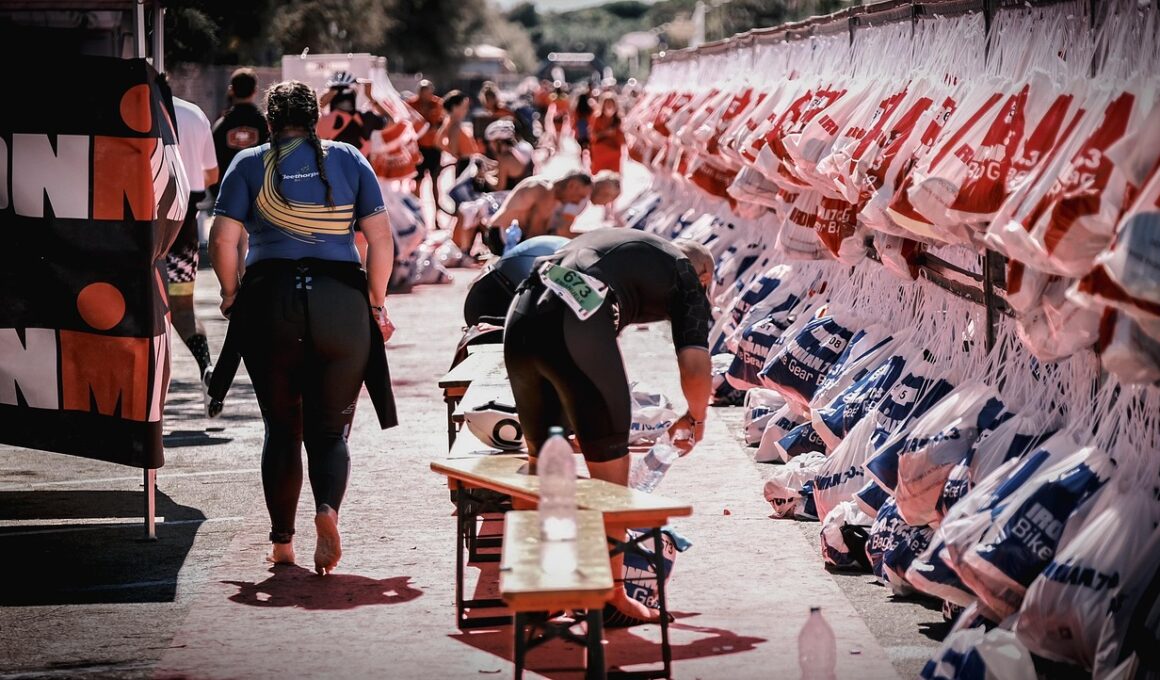Gear Guide: Best Triathlon Equipment for Half-Ironman Competitions
Preparing for a Half-Ironman requires specialized gear designed to enhance performance and comfort. Selecting the right equipment is critical for success during training and on race day. Begin with a good quality wetsuit, which helps maintain body temperature and buoyancy in open water. Look for wetsuits made from flexible materials that allow for a full range of motion. Furthermore, you’ll need a reliable triathlon bike that fits correctly. A lightweight bike reduces fatigue, and various aerodynamic options can be beneficial. Don’t forget about the importance of training on a bike that is well-maintained and comfortable for long rides. In addition to these, running shoes are vital as they need to provide adequate support, durability, and comfort while aiming for your best time. Consider using triathlon-specific shoes that can be easily slipped on during the transition. You should also invest in high-quality goggles, ensuring best visibility during swimming. Finally, hydration packs or belts are crucial for carrying water and nutrition while running, providing necessary energy and hydration. With the right gear, you set yourself up for optimal performance.
Essential Nutrition for Optimal Performance
Nutrition plays an equally essential role in Half-Ironman training as the gear itself. Successfully fueling your body with the right nutrients can significantly influence your performance and recovery. Focus on carbohydrates for energy since you will be pushing your limits during long training sessions. Make sure to consume easily digestible carbs, such as energy gels, bars, or fruit, especially during your run and bike sessions. Additionally, include sources of protein in your diet to support muscle recovery. Foods like lean meats, dairy, or plant-based proteins should complement your regime. Furthermore, maintaining hydration is vital during both training and races. Water and electrolyte drinks help replenish what is lost and prevent fatigue. It’s also advisable to practice your nutrition strategy during training sessions to see what works for you and avoid any gastrointestinal issues on race day. Always remember to eat a well-balanced diet rich in vitamins and minerals to maintain overall health. Various meal plans and pre-race snacks can help you optimize your energy levels and help you avoid common pitfalls. Focus on hydration and nutrition throughout your training journey.
Optimum Training Techniques
In the lead-up to your Half-Ironman, it’s crucial to implement effective and balanced training techniques. Develop a structured training plan that incorporates all three disciplines: swimming, cycling, and running. Aim to build endurance gradually by incorporating long sessions focused on distance and time spent on each activity. Include interval workouts, as they enhance speed and stamina. For example, consider including brick workouts, which involve cycling followed immediately by running to familiarize your body with the transition between bikes and running. Incorporating strength training can improve overall performance, especially in swimming and cycling, which rely heavily on core and leg strength. Regularly assess your times and distances to track your progress, adjusting your training plans accordingly. Furthermore, adequate rest and recovery are equally important. Ensure that you are giving your body enough downtime to recuperate and regain strength after rigorous training sessions. Cross-training activities—such as yoga or pilates—can enhance flexibility and reduce injury risks. Listen to your body and avoid overtraining, as this can significantly hinder performance. Building a well-rounded training regimen is crucial for achieving your Half-Ironman goals.
Once your training is well underway, focusing on transition efficiency is essential. The transitions between swimming, cycling, and running can make a difference in your overall race time. Set up your transition area meticulously, allowing for a seamless shift between disciplines. Utilize a triathlon backpack or specific gear box to keep everything organized and accessible. Every second counts, so practice your transitions during training. Ensure you have all the necessary items laid out for quick access. For example, placing your shoes, helmet, and nutrition in an easily reachable location will help maximize your efficiency. Familiarize yourself with putting on your bike shoes quickly. During your swim sessions, practice exiting the water and transitioning into cycling. Likewise, train for the move from bike to run, as this requires adjustments in your pace and breathing. Staying calm and focused during your transitions can help mitigate any nerves. Plan your wardrobe for race day as well, ensuring comfort and ease of movement. Each segment of training is interconnected; effective transitions can yield better performance results. Hence, treat these transitions as an integral part of your training.
In addition to equipment and training techniques, consider the importance of mental preparation with your Half-Ironman. Your mental strength can influence performance just as much as physical capabilities. This can be developed through strategies like visualization and goal setting, helping keep you motivated throughout the journey. Envision yourself during the race, imagining various scenarios, and how you’ll handle them. Setting both short- and long-term goals can help maintain focus. Consider goals such as mastering your swim technique or improving your running pace. Remember that setbacks may occur during training, and staying resilient in the face of challenges is key. Develop a positive mindset, refrain from negative self-talk, and surround yourself with supportive friends or community. Practicing mindfulness techniques, such as meditation or deep breathing, can significantly reduce anxiety levels for race day. Track your thoughts and feelings leading to the event through journaling, providing clarity and understanding of areas to improve. Mental strength will ultimately carry you through the difficult stretches of the race. Invest in building your mental fortitude alongside physical training for the best results.
On the day of the Half-Ironman competition, being well-prepared can set the tone for success. Arrive early to familiarize yourself with the transition area and race course. Take time to warm up both mentally and physically. Hydrate adequately leading up to the race, but avoid overloading just before the start. Focus on consuming a light breakfast with easily digestible carbs to boost your energy levels prior to the start of the race. Ensure your gear is all set and double-check everything you need, especially your race bib. During the swim, start at a comfortable pace to conserve energy as the swim is lengthy. Once on the bike, focus on maintaining a sustainable effort rather than sprinting. Lastly, as you transition into the run, allow your body to adjust, and settle into a consistent rhythm. Monitor your pace, listen to your body, and fuel accordingly. Breaking the race into segments can help manage longer distances mentally. Remember to enjoy the experience and take pride in your effort, no matter the outcomes. Each race is a learning opportunity for the future.
Post-race recovery is vital for future training and events, so do not overlook it once you cross the finish line. Allow your body sufficient time to recuperate after the taxing effort of a Half-Ironman. Engage in cool-down routines immediately after finishing to promote blood circulation and prevent stiffness. Rehydrate with water and electrolyte-rich sports drinks to restore what is lost during exertion. Consider eating a recovery meal packed with both protein and carbohydrates within a short time frame post-race. This aids in muscle recovery and replenishes energy stores. Implement light stretching to ease tight muscles, and maintain mobility in the days following the race. Listening to your body is key, as each individual will require different lengths of recovery time. Incorporating foam rolling may help alleviate soreness and tension. Monitor your body for any signs of injury and take action if needed. Plan your next training cycle strategically, allowing ample recovery time while still remaining active with lower-intensity workouts. Use this experience to build upon for future races and remember to celebrate your accomplishments as well.


